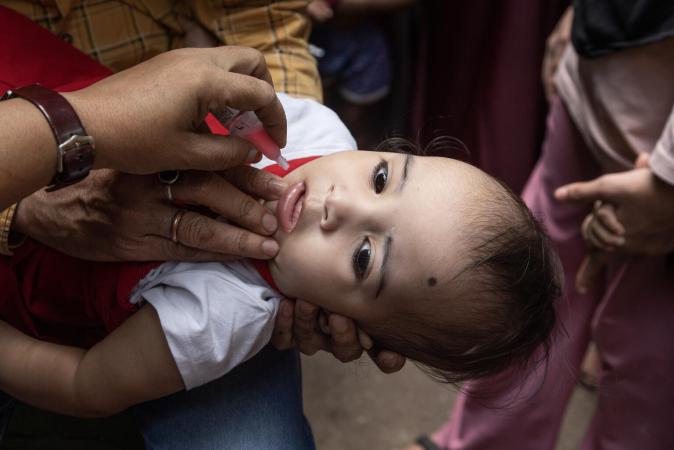New WHO and UNICEF data show immunization coverage is now higher than 2019 levels in Bangladesh, Bhutan, India, Pakistan, and the Maldives
Spokesman Report
KATHMANDU : Immunization services in South Asia reached 1.96 million more children in 2022 compared to the previous year, as countries stepped up efforts to address the historic backsliding in immunization caused by the COVID-19 pandemic and save children’s lives.
According to data published today by UNICEF and the World Health Organization (WHO), in 2022, the coverage of the third dose of the Diphtheria, Pertussis and Tetanus vaccine (DTP3) increased by 6 percentage points, from 85 per cent in 2021 to 91 per cent in South Asia. The DTP vaccine is used as the global marker for immunization coverage.
“South Asia’s progress to catch up with life-saving vaccinations is tremendous news for the children in the region who now have a better chance of being protected against deadly diseases such as measles, tetanus and more,” said UNICEF Deputy Regional Director for South Asia, Noala Skinner. “We owe this progress to the leadership of countries, the investment of donors and partners, tenacity of millions of vaccinators and the commitment of parents to get their children vaccinated despite several challenges during and after the COVID-19 pandemic waves.”
| Proportion of children in South Asia receiving major children’s vaccines (in %) * | |||||||||
| Vaccine | 2019 | 2020 | 2021 | 2022 | |||||
| Vaccine for Tuberculosis (BCG) | 93 | 88 | 87 | 92 | |||||
| First dose of the Diphtheria, Pertussis and Tetanus vaccine (DTP1) | 93 | 88 | 89 | 94 | |||||
| Third dose of the Diphtheria, Pertussis and Tetanus vaccine (DTP3) | 90 | 85 | 85 | 91 | |||||
| First dose against measles (MCV1) | 91 | 88 | 87 | 92 | |||||
| Second dose against measles (MCV2) | 82 | 80 | 81 | 87 | |||||
| Pneumococcal vaccine (PCV3) | 37 | 41 | 44 | 72 | |||||
| Polio (POL3) | 89 | 85 | 85 | 91 | |||||
Among the eight South Asian countries, Bangladesh, Bhutan, Pakistan, India and the Maldives have fully recovered to their pre COVID-19 coverage levels. Sri Lanka and Nepal have made significant strides towards achieving complete recovery but are yet to fully catch-up.
Though progress has been made in Afghanistan, more efforts are needed to reach over 400,000 missing children with vaccination services. All countries, except Afghanistan and Pakistan, achieved vaccine coverage of above 90 per cent for DTP3, which is considered very high.
According to the data, in 2022, India, Sri Lanka, and Nepal had the highest percentage reductions in the number of children who weren’t vaccinated at all, with a decrease of 58 per cent, 50 per cent and 38 per cent respectively. In India, the number of children without any vaccines decreased from 2.7 million in 2021 to 1.13 million in 2022.
The percentage of children vaccinated with the new pneumococcal conjugate vaccines, which protect children against pneumonia, jumped 28 percentage points from 44 in 2021 to 72 per cent in 2022.
Vaccination for the first vaccine dose against measles – one of the most contagious vaccine preventable diseases – increased from 87 per cent in 2021 to 92 per cent in 2022. This was higher than the 2-percentage point increase globally. As a result, an additional 1.94 million children were vaccinated against the deadly disease in South Asia in 2022. However, the regional coverage for the first dose of measles vaccine is still lower than the target of 95 per cent needed to prevent measles outbreaks. According to WHO surveillance data, in 2022 alone, there were 54,959 measles cases in South Asia, nearly triple the reported cases in 2021.
UNICEF worked with countries in the region to boost immunization coverage:
- India used catch-up campaigns and vaccinations to reach children with a primary health care package of health and nutrition interventions.
- In Bangladesh, there were several digital health interventions, including eTracker, GIS-based eMicroplanning and child biometry for immunization, to improve access and make it easier for parents to get their children vaccinated.
- In Pakistan, several initiatives were implemented, including an urban immunization strategy in 5 mega cities, round-the-clock vaccination services in labour rooms and immunization, health, nutrition and water and sanitation services in hard-to-reach areas to address vaccine refusals.
- In Afghanistan, mobile health clinics helped to take vaccinations to unvaccinated children in remote villages.
Despite the progress, an estimated 3 million children out of 34 million surviving infants in South Asia did not receive the three recommended doses of DTP vaccine and are not fully vaccinated. Even within countries, disparities exist which require targeted interventions to vaccinate children.
As part of ‘The Big Catch-Up’ advocacy campaign launched in April this year, UNICEF is calling on South Asian governments to catch up the children who missed vaccinations by doubling down on their commitment to increase financing for immunization and new strategies for immunization programmes to reach every child who was born before or during the pandemic.



